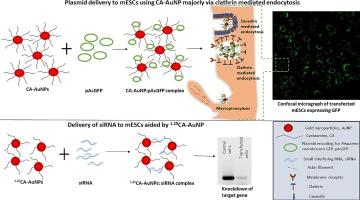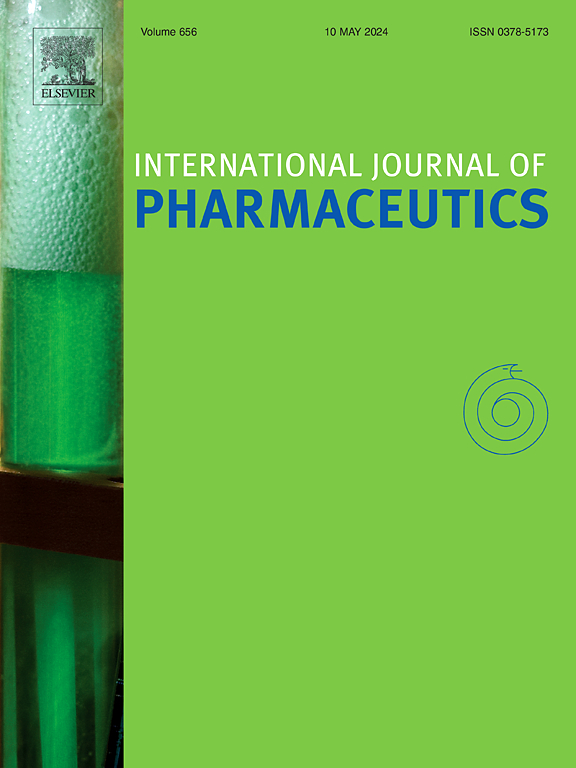Cysteamine functionalized gold nanoparticles exhibit high efficiency delivery of genetic materials in embryonic stem cells majorly via clathrin mediated endocytosis
IF 5.3
2区 医学
Q1 PHARMACOLOGY & PHARMACY
引用次数: 0
Abstract
Efficient and safe gene delivery is vital for genetic manipulation of stem cells for regenerative medicine. Gold nanoparticles have been used for various biomedical applications in the past, and are currently being researched as transfection agents. In this study, we report a simple one-pot synthesis of positively charged gold nanoparticles functionalized with cysteamine. The nanoparticles exhibit no cytotoxicity and can bind to both plasmid DNA (pDNA) as well as small interference RNA (siRNA). We observed that a five fold lower concentration of pDNA was sufficient for achieving comparable overexpression as that of a commercial transfection agent. We also observed that about 70 % transient silencing of the target gene was achieved with only 25 nM siRNA delivered by our nano-vehicle. To better understand the fate of the nanoparticle, we attempted to identify its uptake mechanism. The results indicate that while all the mechanisms contribute to the uptake, the clathrin-dependent pathway plays a major role. This is the first study on understanding the mechanism of uptake of CA-AuNPs conjugated to pDNA by embryonic stem cells. This is also the first study, where a successful transfection using gold based nanoparticles has been achieved in ESCs at a concentration as low as 0.5 µg/ml for pDNA and 25ƞM siRNA.

半胱胺功能化金纳米粒子主要通过凝集素介导的内吞作用在胚胎干细胞中高效传递遗传物质。
高效、安全的基因递送对再生医学干细胞的基因操作至关重要。金纳米粒子过去曾用于各种生物医学应用,目前正被研究用作转染剂。在本研究中,我们报告了一种用半胱胺功能化的带正电荷金纳米粒子的简单单锅合成方法。这种纳米颗粒没有细胞毒性,既能与质粒 DNA(pDNA)结合,也能与小干扰 RNA(siRNA)结合。我们观察到,pDNA 的浓度低五倍就足以实现与商业转染剂相当的过表达。我们还观察到,我们的纳米载体只需输送 25 nM siRNA,就能实现约 70% 的目标基因瞬时沉默。为了更好地了解纳米粒子的命运,我们试图确定其吸收机制。结果表明,虽然所有机制都有助于吸收,但依赖于凝胶酶的途径起着主要作用。这是第一项了解胚胎干细胞摄取与 pDNA 连接的 CA-AuNPs 机制的研究。这也是第一项使用金基纳米颗粒成功转染胚胎干细胞的研究,pDNA和25ƞM siRNA的转染浓度低至0.5微克/毫升。
本文章由计算机程序翻译,如有差异,请以英文原文为准。
求助全文
约1分钟内获得全文
求助全文
来源期刊
CiteScore
10.70
自引率
8.60%
发文量
951
审稿时长
72 days
期刊介绍:
The International Journal of Pharmaceutics is the third most cited journal in the "Pharmacy & Pharmacology" category out of 366 journals, being the true home for pharmaceutical scientists concerned with the physical, chemical and biological properties of devices and delivery systems for drugs, vaccines and biologicals, including their design, manufacture and evaluation. This includes evaluation of the properties of drugs, excipients such as surfactants and polymers and novel materials. The journal has special sections on pharmaceutical nanotechnology and personalized medicines, and publishes research papers, reviews, commentaries and letters to the editor as well as special issues.

 求助内容:
求助内容: 应助结果提醒方式:
应助结果提醒方式:


